Promoting Sustainable Development of Coal Mines: CNN Model Optimization for Identification of Microseismic Signals Induced by Hydraulic Fracturing in Coal Seams
Abstract
1. Introduction
2. Methods
2.1. Different Convolution Methods
2.2. Training Data Acquisition
- (1)
- The STA/LTA method is employed to extract microseismic events with high signal-to-noise ratios from continuous microseismic data (in SGY format). A total of 2449 events were obtained using this method. The long-term window for STA/LTA is set to 200 sampling points, the short-term window to 60 sampling points, and the threshold to 2.8. An event is determined to exist within a time window when more than three channels contain effective waveforms within the same time window. The time window is set to 4000 sampling points. The high threshold setting is to ensure that the events obtained are true microseismic events as much as possible, thereby ensuring the accuracy of the training dataset.
- (2)
- Expert identification is used to select real microseismic events and background noise from the dataset obtained in step (1), with the background noise being placed in the background noise training set. This method selected a total of 1545 real events.
- (3)
- The STA/LTA method is used to select waveforms from the microseismic events obtained in step (2) for the effective waveform training set. This method acquired 9993 microseismic waveforms. The long-term window for STA/LTA is set to 200 sampling points, the short-term window to 60 sampling points, and the threshold to 2.5. The reason for setting the threshold to 2.5 is that when the ratio of the short-term window to the long-term window is 2.5, the waveform is already relatively weak. When this ratio is below 2.5, it becomes difficult to determine whether the waveform represents a weak microseismic waveform or background noise. Compared to step (1), the STA/LTA threshold is lowered in this step because the event has already been confirmed as a real microseismic event, and the microseismic waveforms within the event are genuine. Therefore, the selection threshold can be appropriately reduced. In addition, since not all channels in the event contain effective waveforms, a threshold is set to ensure that the training data in the effective waveform training set differs from the background noise to some extent.
- (4)
- Based on the microseismic waveforms obtained in step (3), repeated noise addition is performed to obtain a total of 809,433 microseismic waveforms. “Repeated” means that noise is added to the original waveform 1 to obtain waveform 2, then the same noise is added to waveform 2 to obtain waveform 3, and this process is repeated until waveform n is obtained. The number of noise additions was 80.
- (5)
- The STA/LTA method is used to detect all waveforms obtained in step (4). The STA/LTA threshold is set to 2.4, and waveforms with a signal-to-noise ratio above 2.4 are considered effective waveforms. The reason for setting the threshold to 2.4 is that it has already been determined that these waveforms are real, even if they are relatively weak. Together with the original waveform data, a total of 489,496 microseismic waveforms were obtained.
- (1)
- The STA/LTA method is used to extract background noise waveform segments from continuous microseismic data (in SGY format). When the ratio of the short-term window to the long-term window is less than 2.2 for all channels within the same time window, the waveform segment is considered background noise. This method acquired a total of 433,580 background noise training data points. Together with the background noise obtained in step (2) of the effective waveform training dataset acquisition, a total of 434,392 background noise data points were obtained. The long-term window for STA/LTA is set to 200 sampling points, the short-term window to 60 sampling points, and the threshold to 2.2.
- (2)
- The expert checked the background noise training data obtained in step (1) and did not find any misidentification data. A total of 434,392 background noise training data points were obtained through this method.
2.3. Ultra-Light CNN Models
- (1)
- Decomposition of larger convolutional kernels into smaller ones in series. For instance, a 5 × 5 kernel is decomposed into two 3 × 3 kernels, a 7 × 7 kernel into a 1 × 7 and a 7 × 1 kernel, and a 3 × 3 kernel into a 1 × 3 and a 3 × 1 kernel. This approach benefits from a decreased parameter count, ultimately accelerating training.
- (2)
- When pooling first and then convolving there is more information loss, and the feature extraction ability of the model decreases; convolution before pooling requires a large amount of computation. Pooling and convolution should be parallelized. This model structure uses two parallel modules with stride 2, replacing serial with parallel.
- (1)
- The Mobilenet architecture model introduces the SE (Squeeze and Excitation) module and the h-swift activation function. The SE module enhances channel interaction and contextual information transmission in the network by adaptively learning the processing weights of channels, thereby improving the recognition ability of feature maps. The h-swift activation function is a new type of nonlinear activation function that can better enhance the nonlinear expression ability of the model.
- (2)
- The MobileNet structural model adopts an inverted residual structure, which introduces a bottleneck layer between input and output to reduce computational complexity and memory usage. At the same time, by using the ReLU6 nonlinear activation function in the bottleneck layer, the nonlinear expression ability of the model is further enhanced.
2.4. Threshold Adjustment Strategies and Ultra-Lightweight CNN Integration Method
3. Results
3.1. Training and Testing Results
3.2. Transmission Law of Feature Maps
4. Discussion
5. Conclusions
- (1)
- The threshold is automatically adjusted based on the error between the number of events identified by the model and the actual number of events. As iterations progress, the threshold variation gradually decreases, approaching an optimal threshold. The threshold precision reaches up to 26 decimal places.
- (2)
- Using the method proposed in this article to identify microseismic waveforms in the hydraulic fracturing in coal seam in the Xieqiao Mine effectively improves the recognition effect of microseismic waveforms. The voting ensemble model built based on Ul Perception28, Ul-ResNet12, and Ul-TripleConv8 methods has improved the F1 index by at least 0.0452 compared to a single CNN model, and by 0.1552 compared to the STA/LTA method commonly used in coal mines.
- (3)
- When the entropy of feature maps across various layers and channels consecutively reaches zero, it can compromise the transmission of feature maps, leading to poor model performance. Factors like a high number of model parameters, a small receptive field of convolutional layers, or insufficient parameters can contribute to consecutive zero entropies in feature maps across layers and channels. The training dataset, expanded from thousands of waveform data, is more suitable for CNN models with parameter counts in the tens of thousands. It is challenging to achieve good performance with CNN models that have millions or tens of millions of parameters.
- (4)
- By integrating ultra-lightweight CNN models to identify microseismic events, it is helpful to characterize more complete hydraulic fracturing fractures in coal seams, thereby more accurately evaluating the fracturing effect and releasing pressure in stress concentration areas more precisely. We plan to integrate more types of ultra-lightweight deep learning models to further improve the accuracy of microseismic waveform recognition. This study can provide reference and guidance for the prevention and control of coal mine dynamic disasters based on hydraulic fracturing in coal seams.
Author Contributions
Funding
Institutional Review Board Statement
Informed Consent Statement
Data Availability Statement
Acknowledgments
Conflicts of Interest
References
- Yuan, L.; Wang, E.Y.; Ma, Y.K.; Liu, Y.B.; Li, X.L. Research progress of coal and rock dynamic disasters and scientific and technological problems in China. J. China Coal Soc. 2023, 48, 1825–1845. [Google Scholar]
- Cao, A.Y.; Dou, L.M.; Bai, X.X.; Liu, Y.Q.; Yang, K.; Li, J.Z.; Wang, B. State-of-the-art occurrence mechanism and hazard control of mining tremors and their challenges in Chinese coal mines. J. China Coal Soc. 2023, 48, 1894–1918. [Google Scholar]
- Li, N.; Fang, L.L.; Sun, W.C.; Zhang, X.; Chen, D. Evaluation of Borehole Hydraulic Fracturing in Coal Seam Using the Microseismic Monitoring Method. Mec. Roches. 2021, 54, 607–625. [Google Scholar] [CrossRef]
- Yuan, L.; Lin, B.Q.; Yang, W. Research progress on hydraulic fracture characteristics and controlling factors of coalbed methane reservoirs. J. China Coal Soc. 2023, 48, 4443–4460. [Google Scholar]
- Zenchenko, E.V.; Turuntaev, S.B.; Nachev, V.A.; Chumakov, T.K.; Zenchenko, P.E. Study of the Interaction of a Hydraulic Fracture with a Natural Fracture in a Laboratory Experiment Based on Ultrasonic Transmission Monitoring. Energies 2024, 17, 277. [Google Scholar] [CrossRef]
- Zhang, Y.P.; Li, N.; Sun, L.H.; Qiu, J.C.; Huang, X.K.; Li, Y. Recognition of Weak Microseismic Events Induced by Borehole Hydraulic Fracturing in Coal Seam Based on ResNet-10. Appl. Sci. 2024, 14, 80. [Google Scholar] [CrossRef]
- Lu, Z.H.; Jia, Y.Z.; Cheng, L.J.; Pan, Z.J.; Xu, L.J.; He, P.; Guo, X.Z.; Ouyang, L.M. Microseismic Monitoring of Hydraulic Fracture Propagation and Seismic Risks in Shale Reservoir with a Steep Dip Angle. Nat. Resour. Res. 2022, 31, 2973–2993. [Google Scholar] [CrossRef]
- Li, D.K.; He, Z.R.; Zhang, Z.D.; Zou, Y.S.; Wang, X.Q.; Xie, F. A new template matching based acoustic emission detection procedure and its application in laboratory hydraulic fracturing experiment. Chin. J. Geophys. 2023, 66, 4386–4401. [Google Scholar]
- Li, N.; Sun, W.C.; Huang, B.X.; Chen, D.; Zhang, S.H.; Yan, M.Y. Acoustic Emission Source Location Monitoring of Laboratory-Scale Hydraulic Fracturing of Coal Under True Triaxial Stress. Nat. Resour. Res. 2021, 30, 2297–2315. [Google Scholar] [CrossRef]
- Chen, G.Y.; Yang, W.; Tan, Y.Y.; Zhang, H.J.; Li, J.L. Automatic phase detection and arrival picking for microseismic events in hydraulic fracturing based on machine learning and array correlation. Chin. J. Geophys. 2023, 66, 1558–1574. [Google Scholar]
- Allen, Automatic earthquake recognition and timing from single trace. Seismol. Soc. Am. Bull. 1978, 68, 1521–1532. [CrossRef]
- Akaike, H. A new look at the statistical model identification. IEEE Ttansactions Autom. Control. 1974, 19, 716–723. [Google Scholar] [CrossRef]
- Gibbons, S.J.; Ringdal, F. The detection of low magnitude seismic events using array-based waveform correlation. Coal Sci. Technol. 2010, 165, 149–166. [Google Scholar] [CrossRef]
- Xu, H.Y.; Zhao, Y.; Yang, T.H.; Wang, S.H.; Chang, Y.Q.; Jia, P. An automatic P-wave onset time picking method for mining-induced microseismic data based on long short-term memory deep neural network. Geomat. Nat. Hazards Risk. 2022, 13, 908–933. [Google Scholar] [CrossRef]
- Zhang, J.Y.; Dong, L.j.; Xu, N.W. Noise Suppression of Microseismic Signals via Adaptive Variational Mode Decomposition and Akaike Information Criterion. Criterion 2020, 10, 3790. [Google Scholar] [CrossRef]
- Zhang, Y.N.; Li, H.Y.; Zhang, S.Z.; Li, Y.Z.; Huang, Y.F.; Zhong, W.X. Microseismic detection and location in Shanghai and its adjacent areas. Chin. J. Geophys.-Chin. Ed. 2023, 66, 1113–1124. [Google Scholar]
- Shan, P.F.; Yan, Z.M.; Lai, X.P.; Xu, H.C.; Hu, Q.X.; Guo, Z.A. An analytical methodology of rock burst with fully mechanized top-coal caving mining in steeply inclined thick coal seam. Sci. Rep. 2024, 14, 451. [Google Scholar] [CrossRef]
- Hinton, G. Salakhutdinov, Reducing the dimensionality of data with neural networks. Science 2006, 313, 504–507. [Google Scholar] [CrossRef]
- Lecun, Y.; Bengio, Y.; Hinton, G. Deep Learning. Nature 2015, 521, 436–444. [Google Scholar] [CrossRef]
- Tamura, H. An analysis of information segregation in parallel streams of a multi-stream convolutional neural network. Sci. Rep. 2024, 14, 9097. [Google Scholar] [CrossRef]
- Fan, W.Q.; Li, X.Y.; Liu, Z.C. Fusion of visible and infrared images using GE-WA model and VGG-19 network. Sci. Rep. 2023, 13, 190. [Google Scholar] [CrossRef] [PubMed]
- Guan, K.N.; Sun, Y.; Yang, G.; Yang, X.H. Knowledge Acquisition and Reasoning Model for Welding Information Integration Based on CNN and Knowledge Graph. Electronics 2015, 12, 1275. [Google Scholar] [CrossRef]
- Wen, T.H.; Hung, J.M.; Huang, W.H.; Jhang, J.; Lo, Y.C.; Hsu, H.H.; Ke, Z.E.; Chen, Y.C.; Chin, Y.H.; Su, I.; et al. Fusion of memristor and digital compute-in-memory processing for energy—efficient edge computing. Science 2024, 384, 325–332. [Google Scholar] [CrossRef]
- Rusyn, B.; Lutsyk, O.; Kosarevych, R.; Maksymyuk, T.; Gazda, J. Features extraction from multi-spectral remote sensing images based on multi-threshold binarization. Sci. Rep. 2023, 13, 19655. [Google Scholar] [CrossRef] [PubMed]
- Fakhouri, H.N.; Alawadi, S.; Awaysheh, F.M.; Hamad, F. Novel hybrid success history intelligent optimizer with Gaussian transformation: Application in CNN hyperparameter tuning. Clust. Comput. 2023, 27, 3717–3739. [Google Scholar]
- Baccari, B.; Krouma, A. Rhizosphere Acidification Determines Phosphorus Availability in Calcareous Soil and Influences Faba Bean (Vicia faba) Tolerance to P Deficiency. Sustainability 2023, 15, 6203. [Google Scholar] [CrossRef]
- Wang, H.C.; Alkhalifah, T.; bin Waheed, U.; Birnie, C. Data-Driven Microseismic Event Localization: An Application to the Oklahoma Arkoma Basin Hydraulic Fracturing Data. IEEE Trans. Geosci. Remote Sens. 2022, 60, 1–12. [Google Scholar] [CrossRef]
- Zhao, M.; Tang, L.; Chen, S.; Su, J.R.; Zhang, M. Machine learning based automatic foreshock catalog building for the 2019 Ms6.0 Changning, Sichuan earthquake. Chin. J. Geophys. 2021, 64, 54–66. [Google Scholar]
- Ma, Y.Z.; Zhu, S.T.; Pan, J.F.; Gao, Y.T.; Zhang, X.F.; Jiang, F.X.; Liu, J.H.; Wang, B.; Chen, Y. Identification and on-site application of the main hazard-causing stratum of overlying strata in coal mines. J. China Coal Soc. 2024, 49, 2589–2603. [Google Scholar]
- Zhang, X.J.; Liu, X.; Wang, Y.C. Study on the evolution and prediction of stratified burst in hard rocks based on disturbance and interlayer interaction. J. Min. Satety Eng. 2024, 41, 504–510. [Google Scholar]
- Peng, P.A.; Lei, R.; Wang, J.M. Enhancing Microseismic Signal Classification in Metal Mines Using Transformer-Based Deep Learning. Sustainability 2023, 15, 14959. [Google Scholar] [CrossRef]
- Choi, J.; Byun, J.; Seol, S.J.; Lee, S.K. Convolutional neural network-based moment tensor inversion using domain adaptation for microseismicity monitoring. Explor. Geophys. 2023, 54, 133–143. [Google Scholar] [CrossRef]
- Li, J.M.; Tang, S.B.; Weng, F.W.; Li, K.Y.; Yao, H.W.; He, Q.Y. Waveform recognition and process interpretation of microseismic monitoring based on an improved LeNet5 convolutional neural network. Coal Sci. Technol. 2023, 30, 904–918. [Google Scholar] [CrossRef]
- Zhang, X.L.; Wang, X.H.; Zhang, Z.H.; Wang, Z.H. CNN-Transformer for Microseismic Signal Classification. Electronics 2023, 12, 2468. [Google Scholar] [CrossRef]
- Tian, J.H.; Tian, Z.C.; Zhang, M.W.; Meng, Q.B.; Zhang, A.H.; Liu, C.; Jia, L. A novel identification method of microseismic events based on empirical mode decomposition and artificial neural network features. J. Appl. Geophys. 2024, 222, 105329. [Google Scholar] [CrossRef]
- Wang, Y.J.; Qiu, Q.; Lan, Z.Q.; Chen, K.Y.; Zhou, J.; Gao, P.; Zhang, W. Identifying microseismic events using a dual-channel CNN with wavelet packets decomposition coefficients. Comput. Geosci. 2022, 166, 105164. [Google Scholar] [CrossRef]
- Dong, L.J.; Shu, H.M.; Tang, Z.; Yan, X.H. Microseismic event waveform classification using CNN-based transfer learning models. Nt. J. Min. Sci. Technol. 2023, 33, 1203–1216. [Google Scholar] [CrossRef]
- Shu, H.M.; Dawod, A.Y. Microseismic Monitoring Signal Waveform Recognition and Classification: Review of Contemporary Techniques. Appl. Sci. 2023, 13, 12739. [Google Scholar] [CrossRef]
- Li, X.G.; Feng, S.; Guo, Y.T.; Li, H.Y.; Zhou, Y.J. Denoising Method for Microseismic Signals with Convolutional Neural Network Based on Transfer Learning. Int. J. Comput. Intell. Syst. 2023, 16, 91. [Google Scholar] [CrossRef]
- Ma, Y.Y.; Eaton, D.; Igonin, N.; Wang, Y. Machine learning-assisted processing workflow for multi-fiber DAS microseismic data. Front. Earth Sci. 2023, 11, 1096212. [Google Scholar] [CrossRef]
- Di, Y.Y.; Wang, E.Y.; Li, Z.H.; Liu, X.F.; Huang, T.; Yao, J.J. Comprehensive early warning method of microseismic, acoustic emission, and electromagnetic radiation signals of rock burst based on deep learning. Int. J. Rock. Mech. Min. Sci. 2023, 170, 105519. [Google Scholar] [CrossRef]
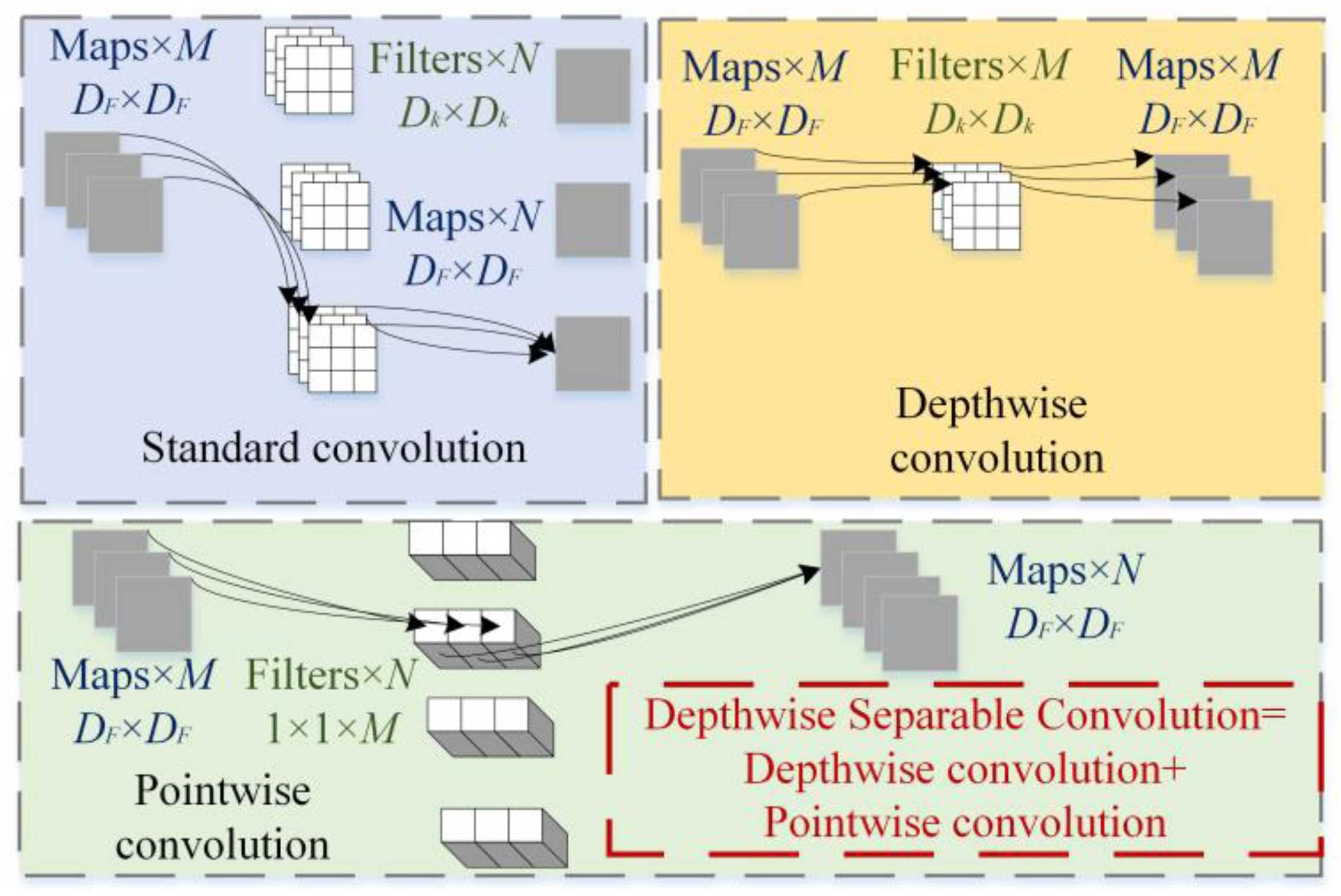
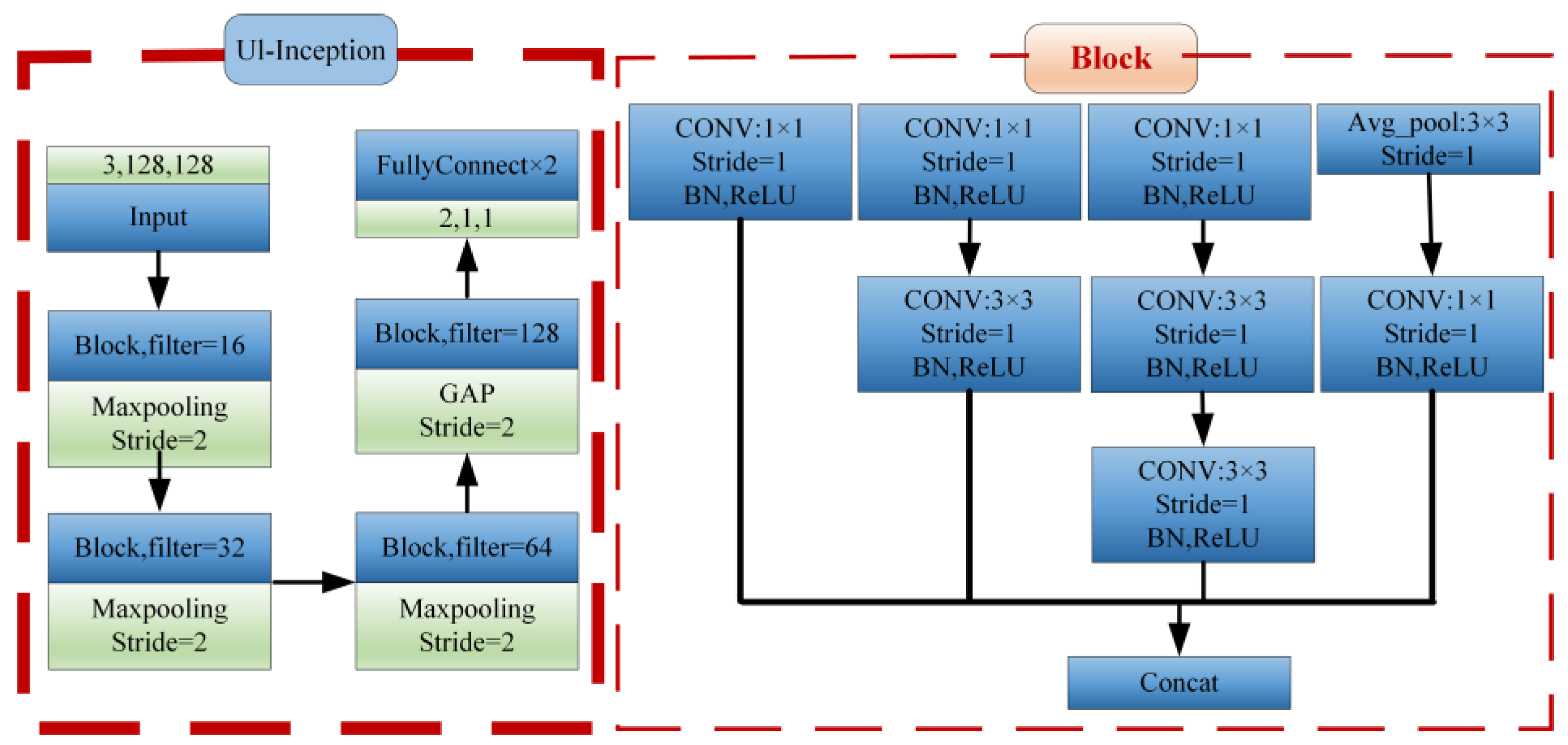

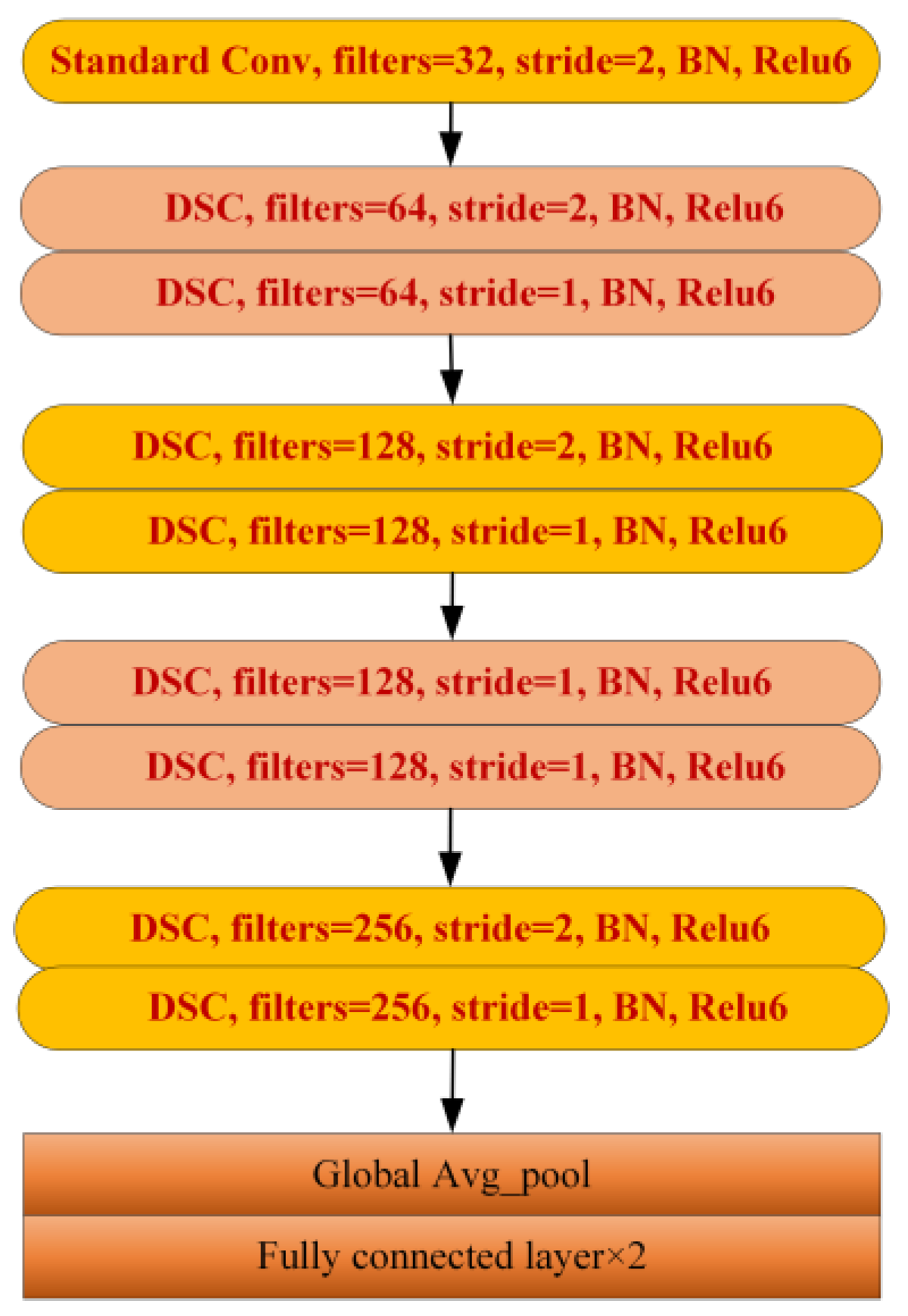
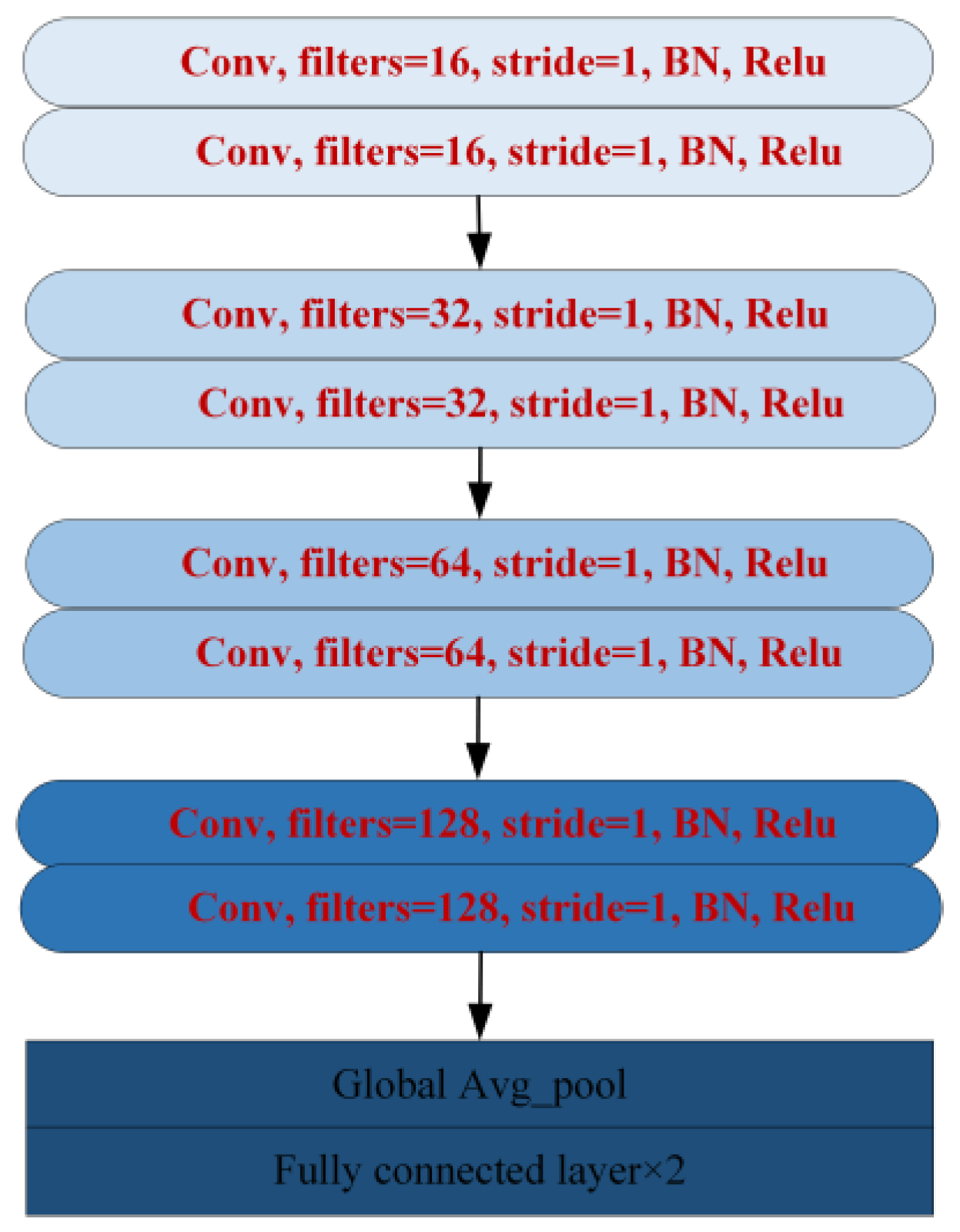
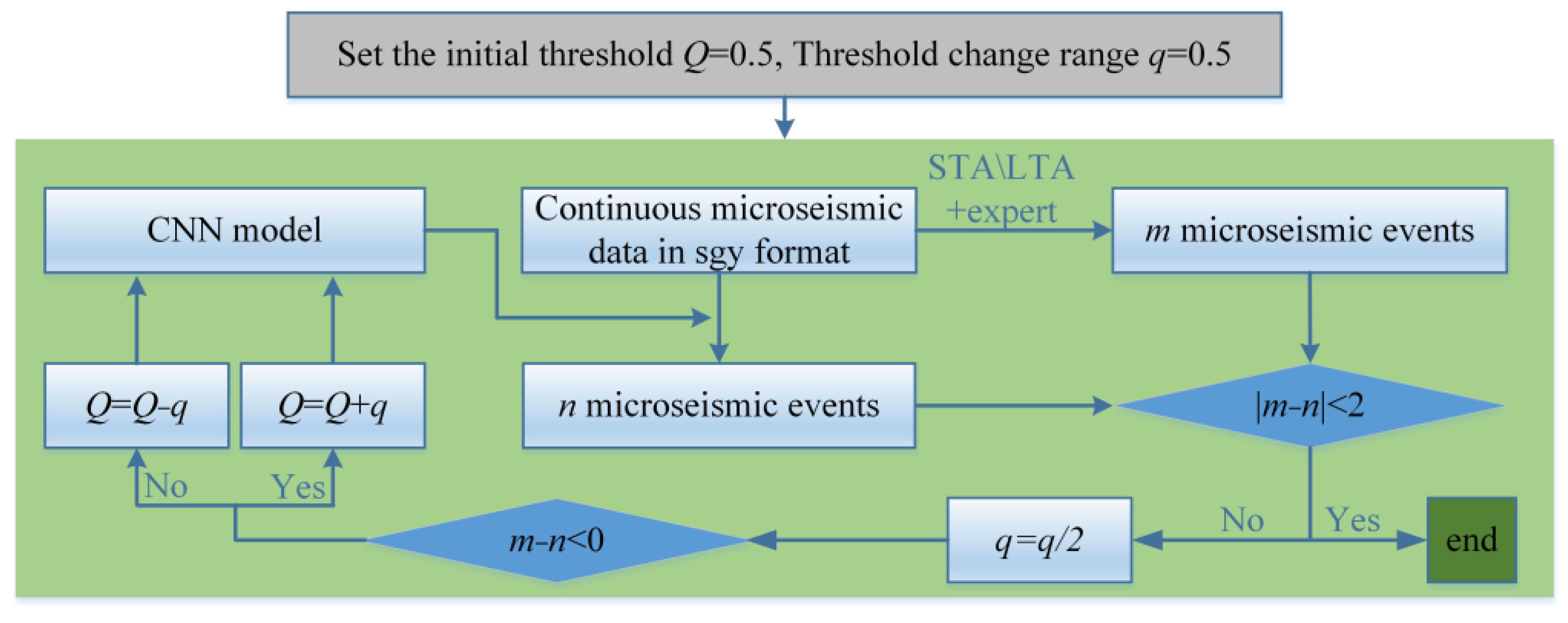
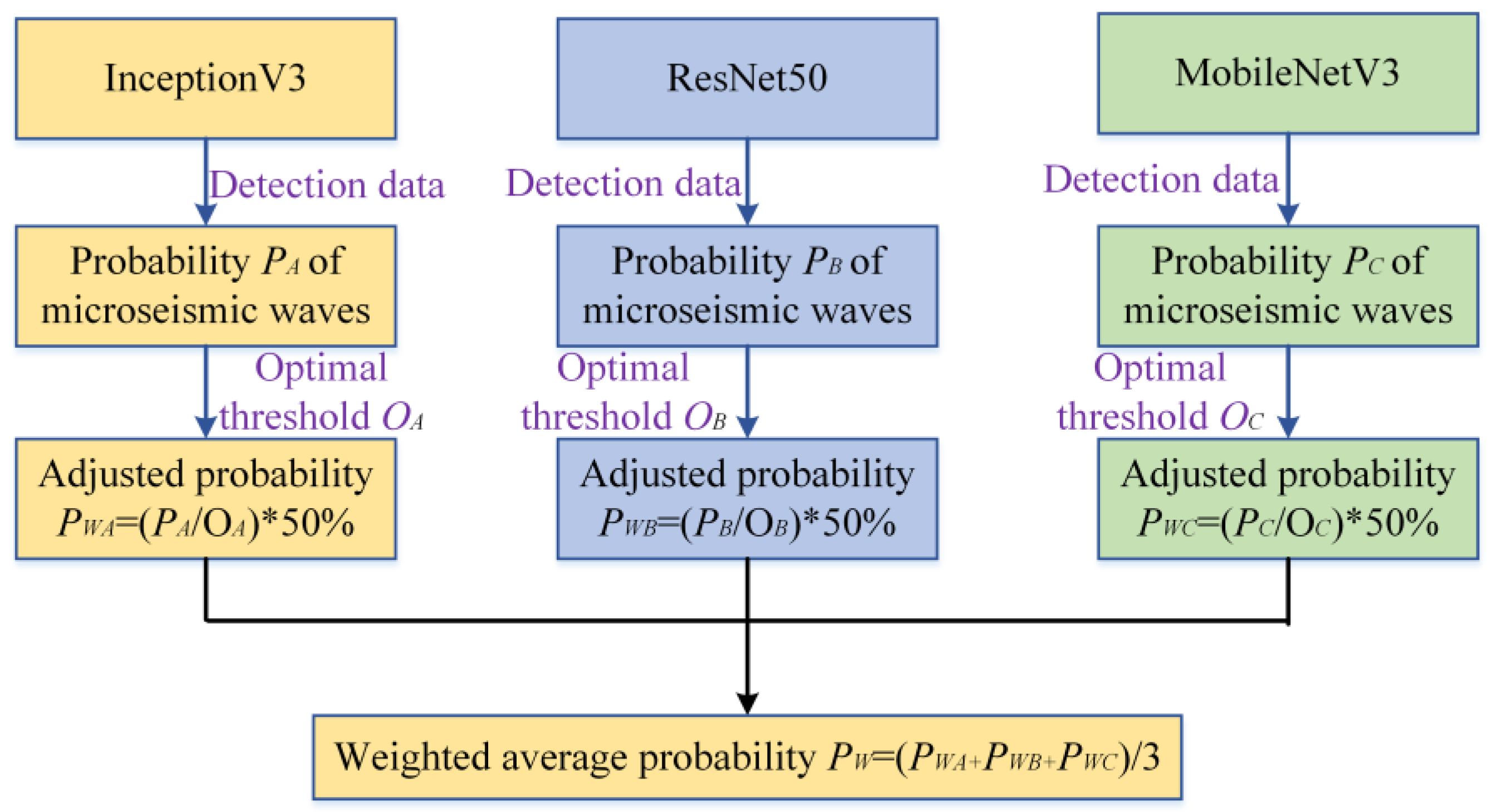
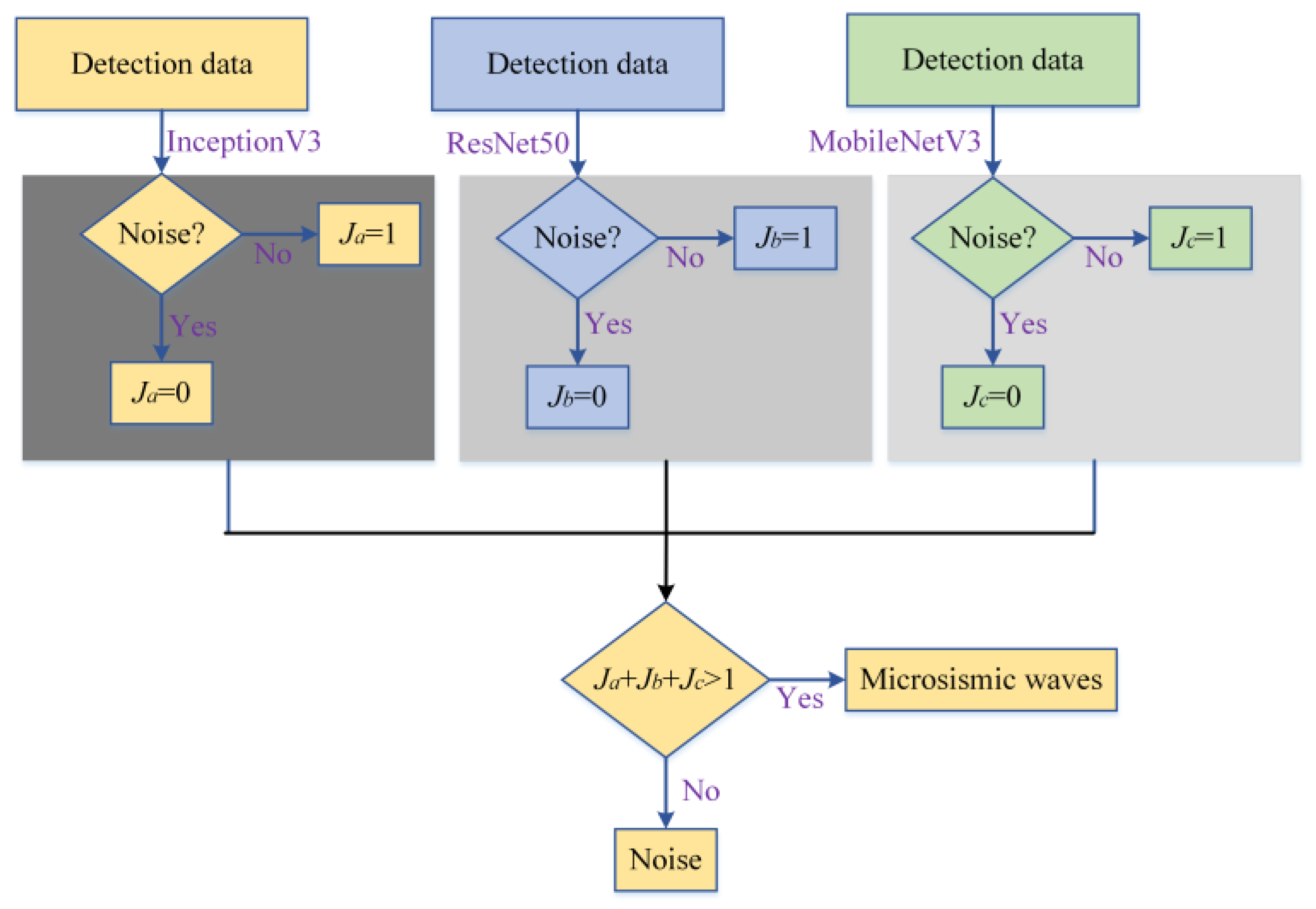
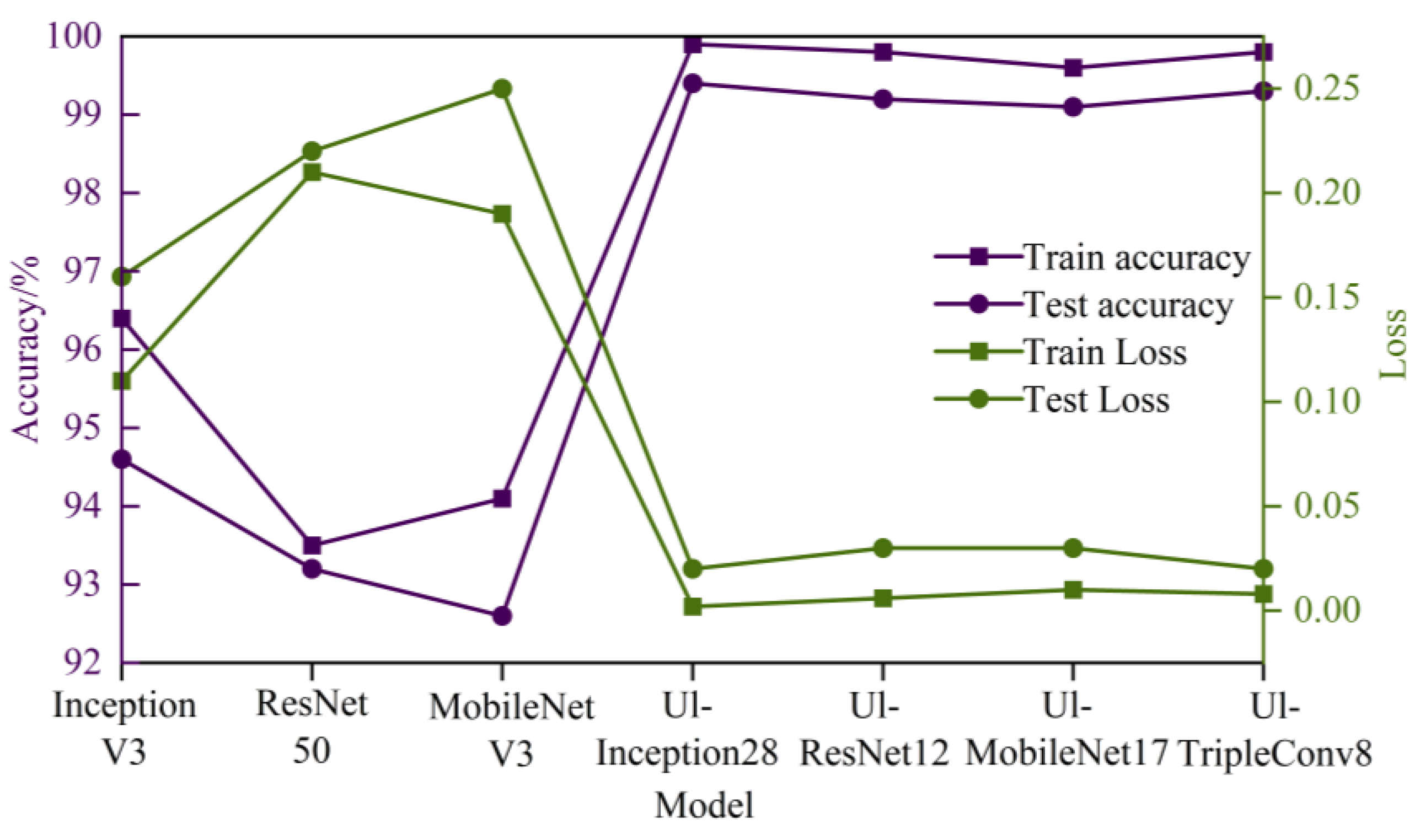
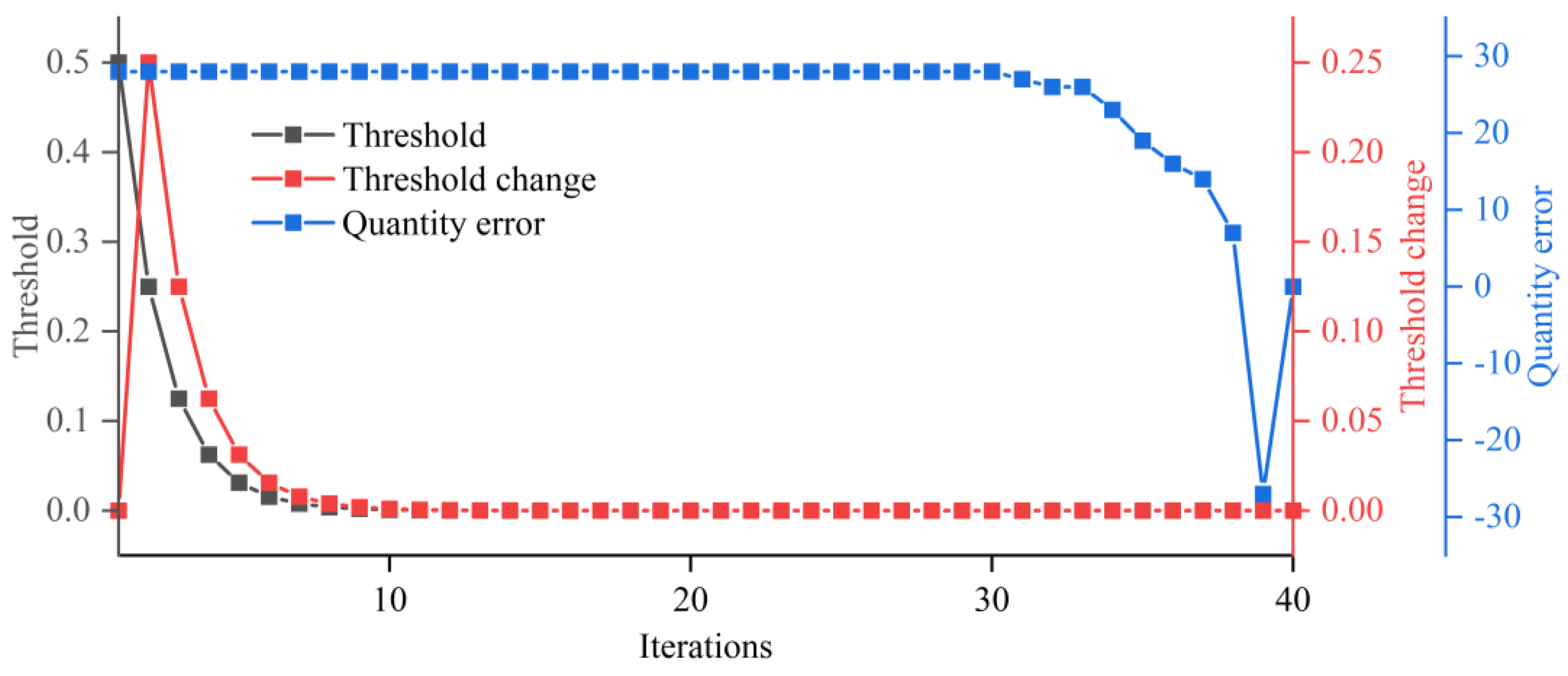
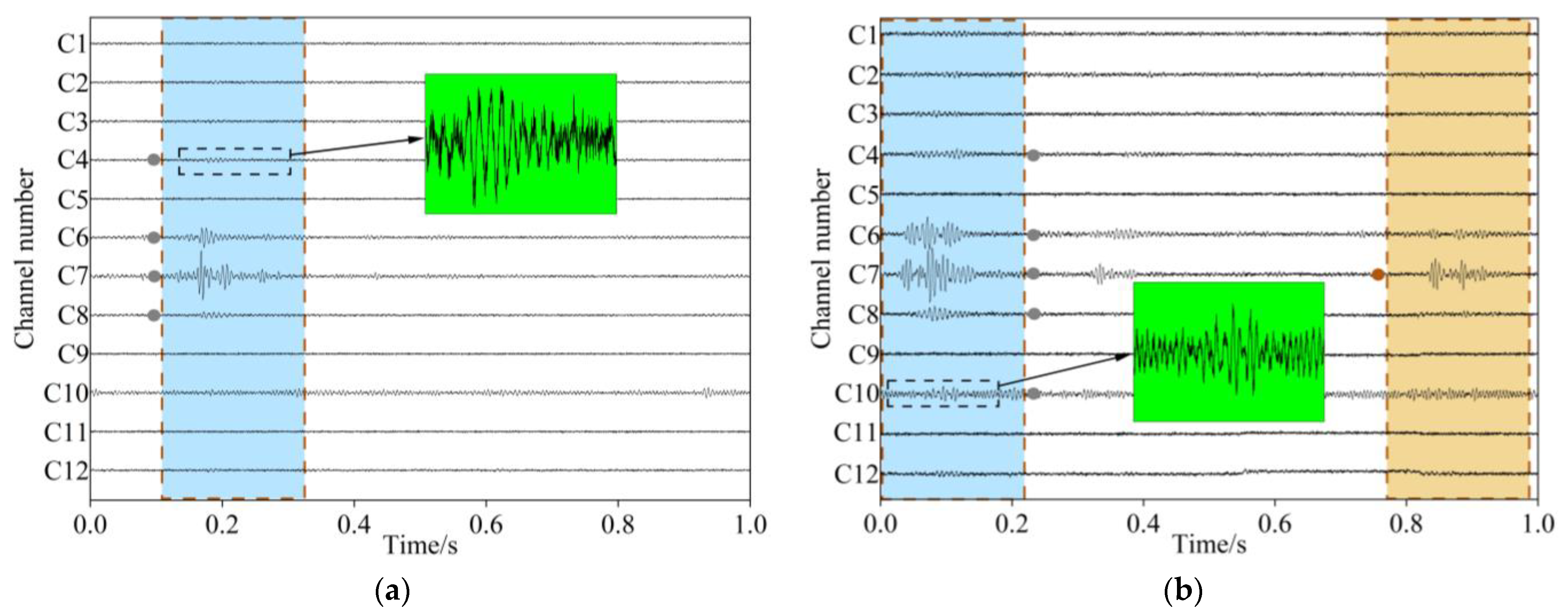
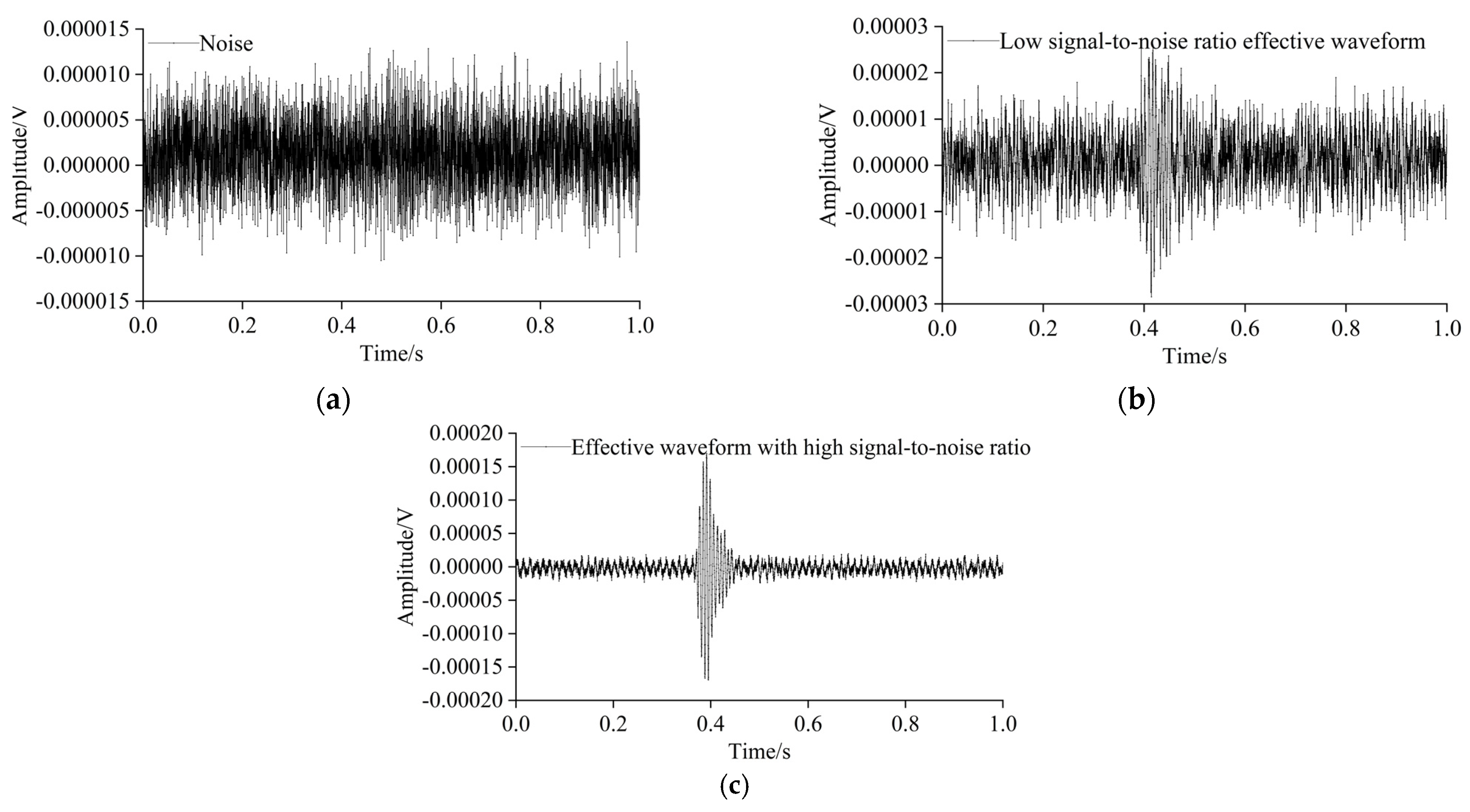
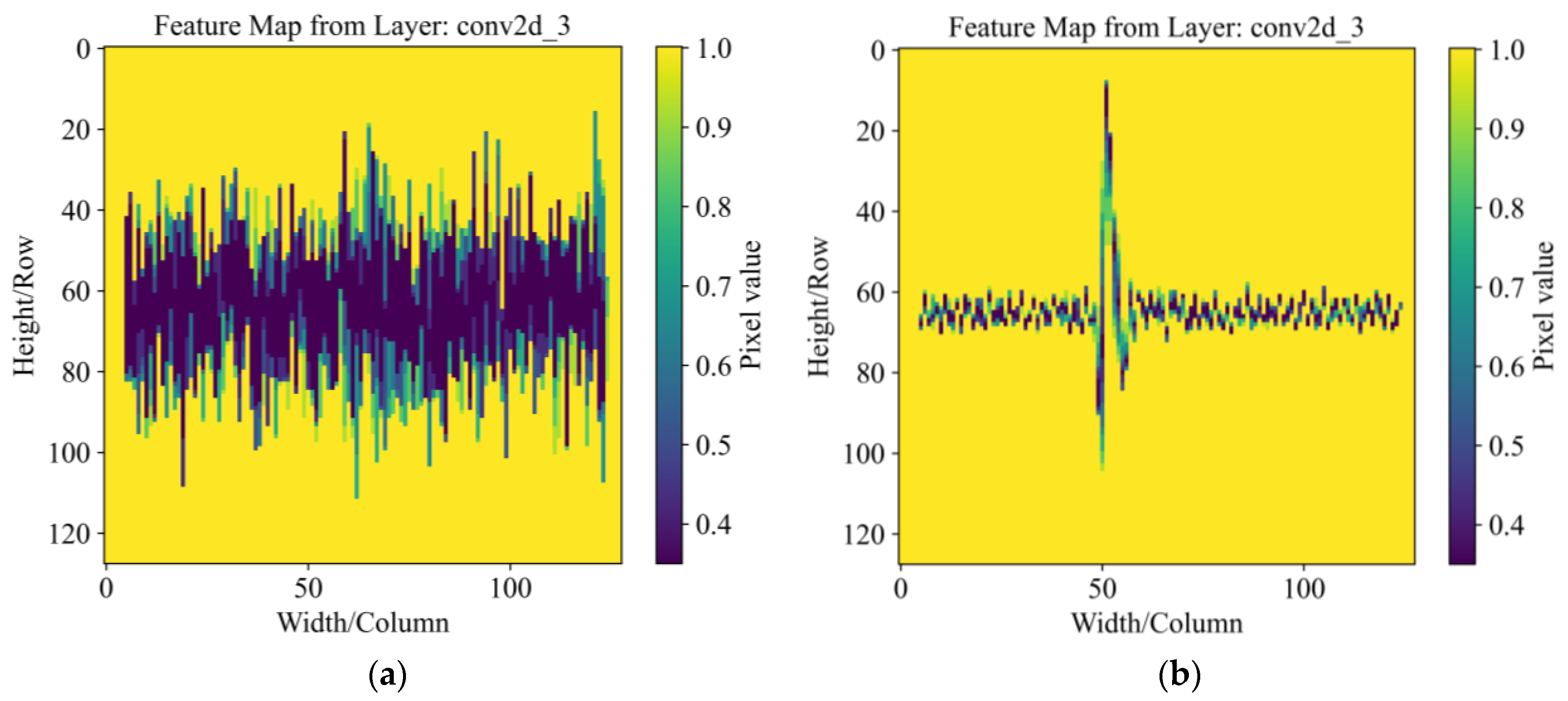
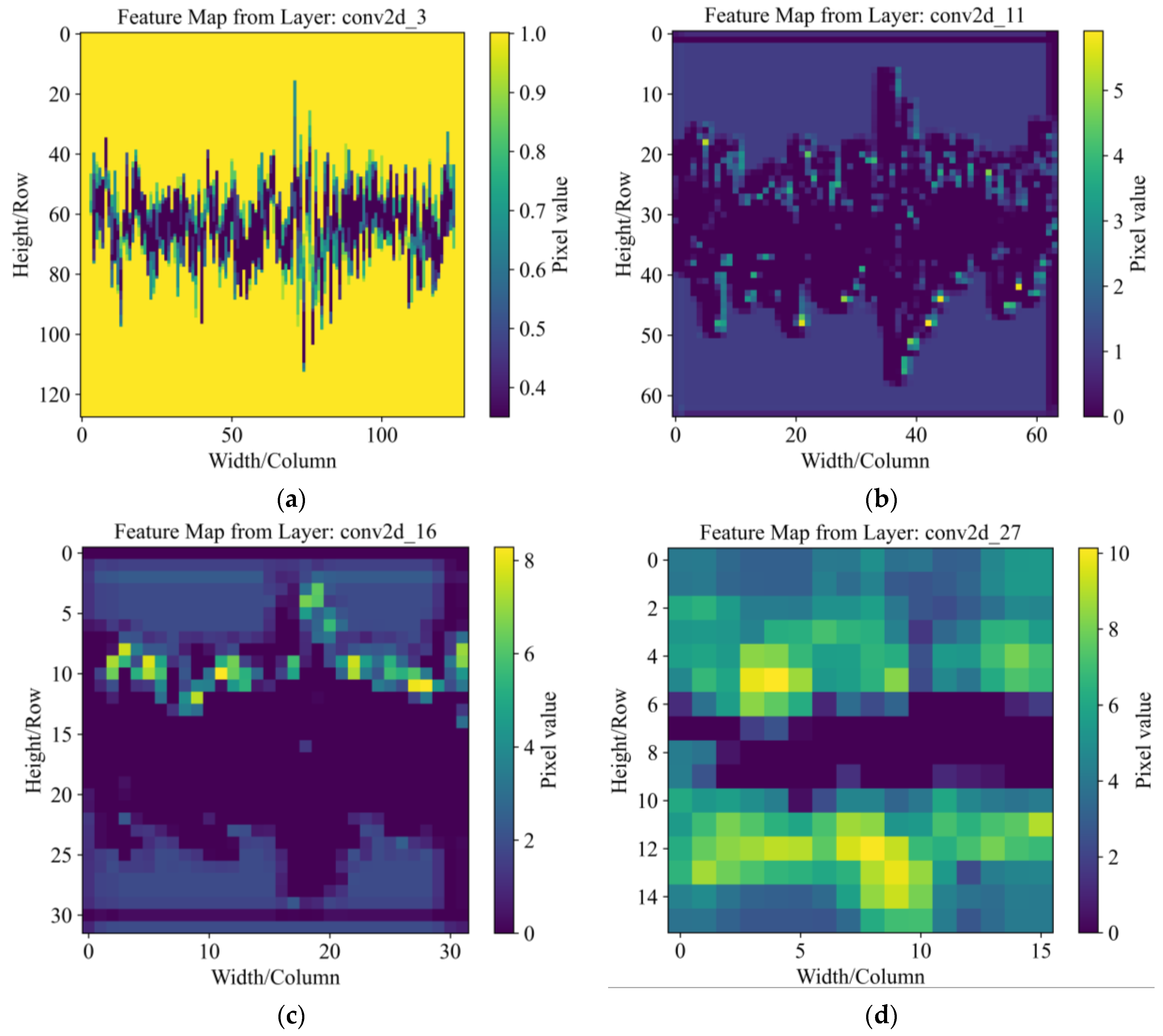
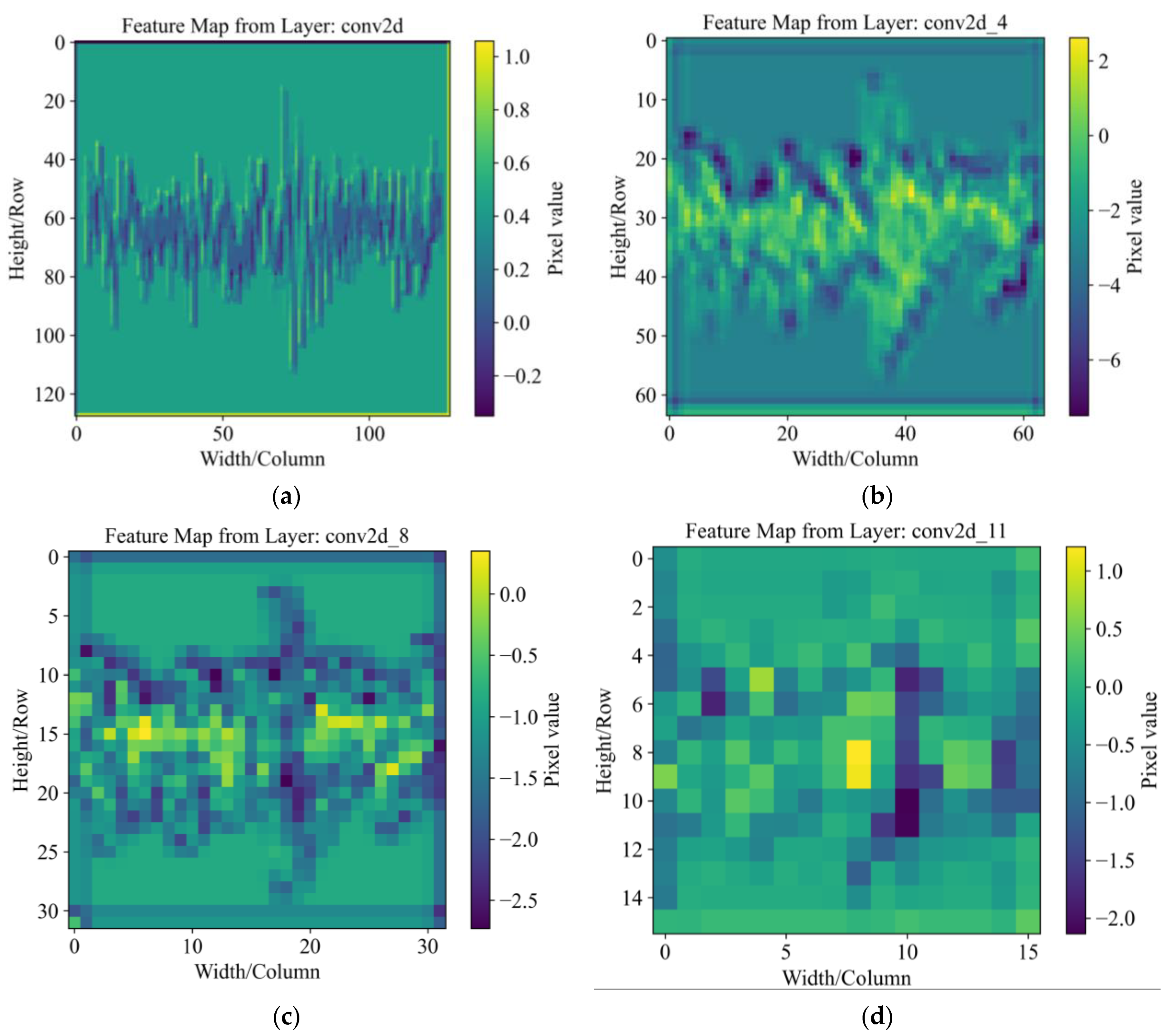
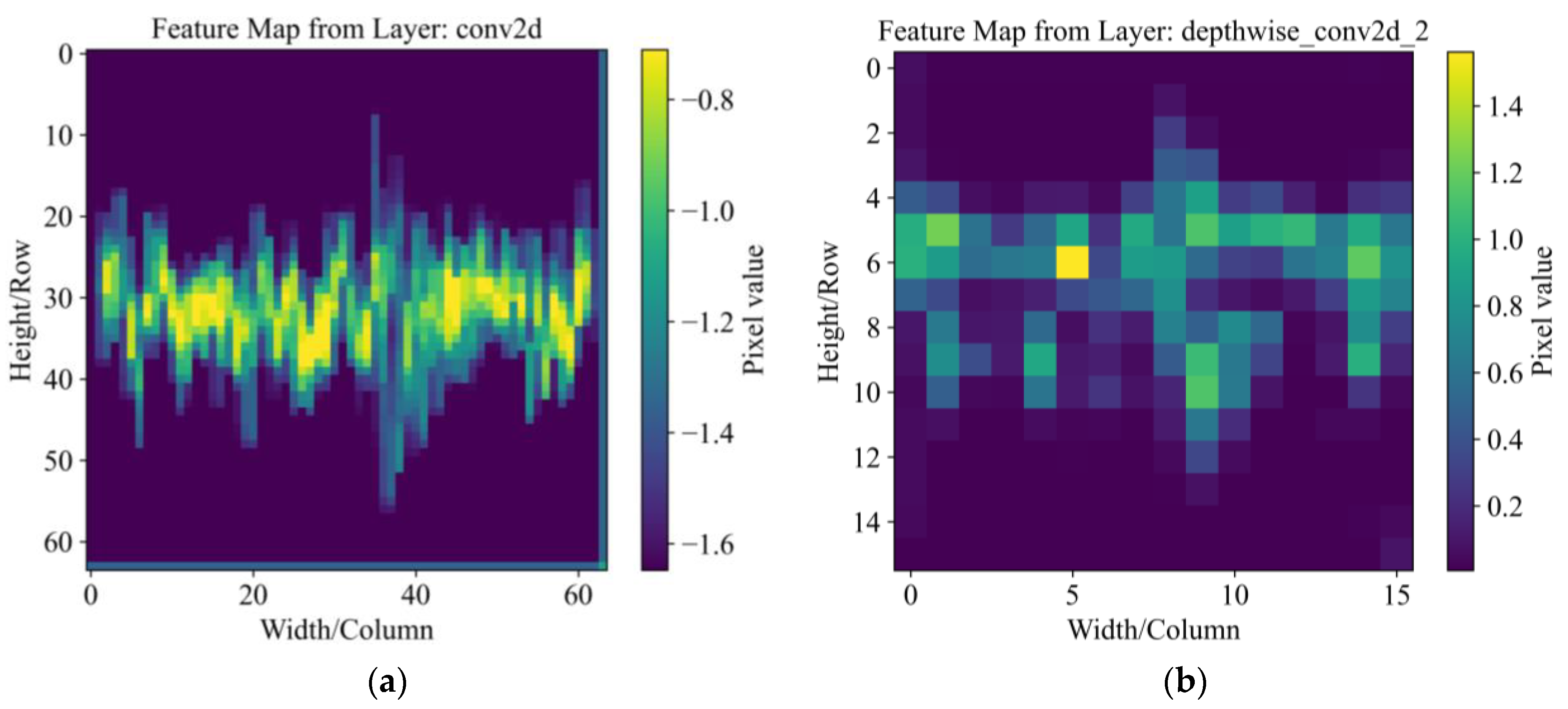
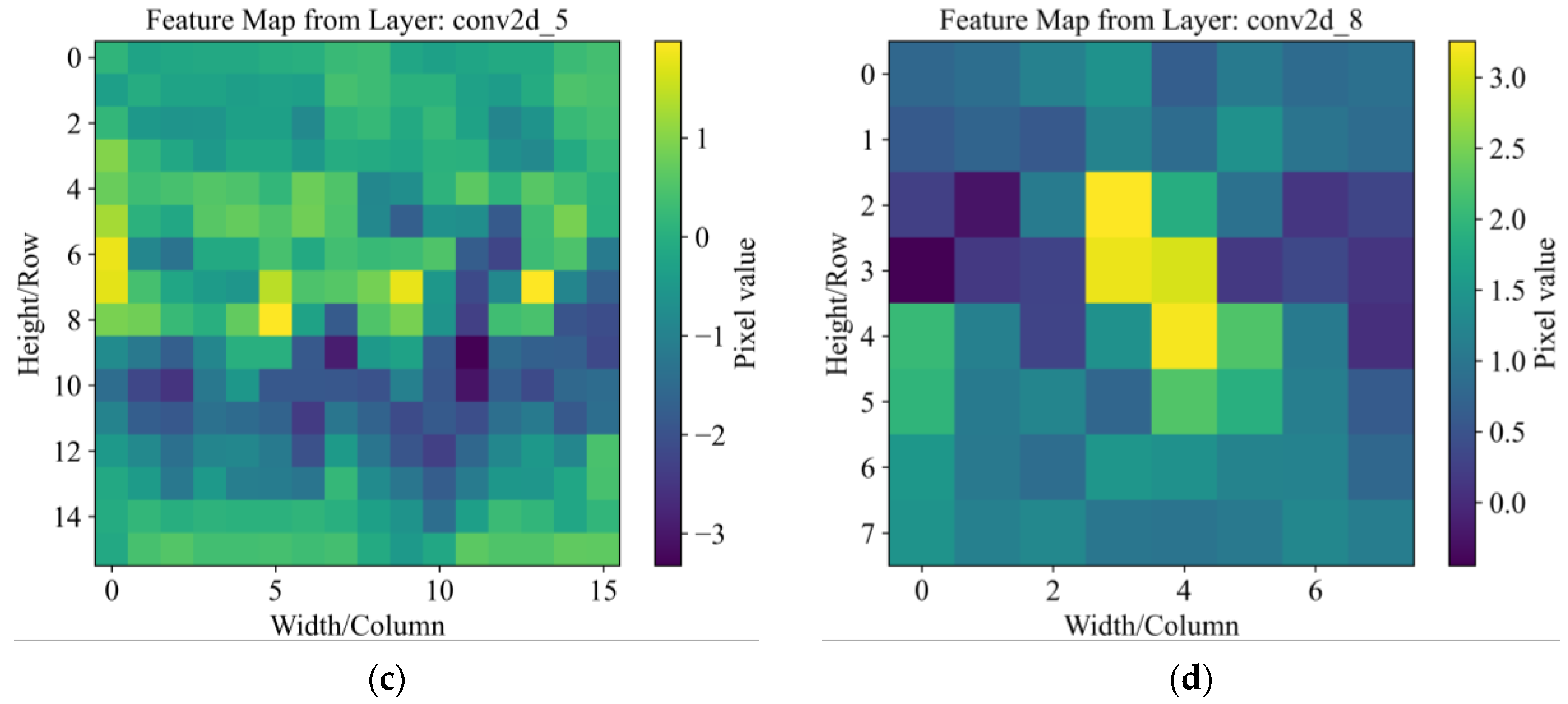

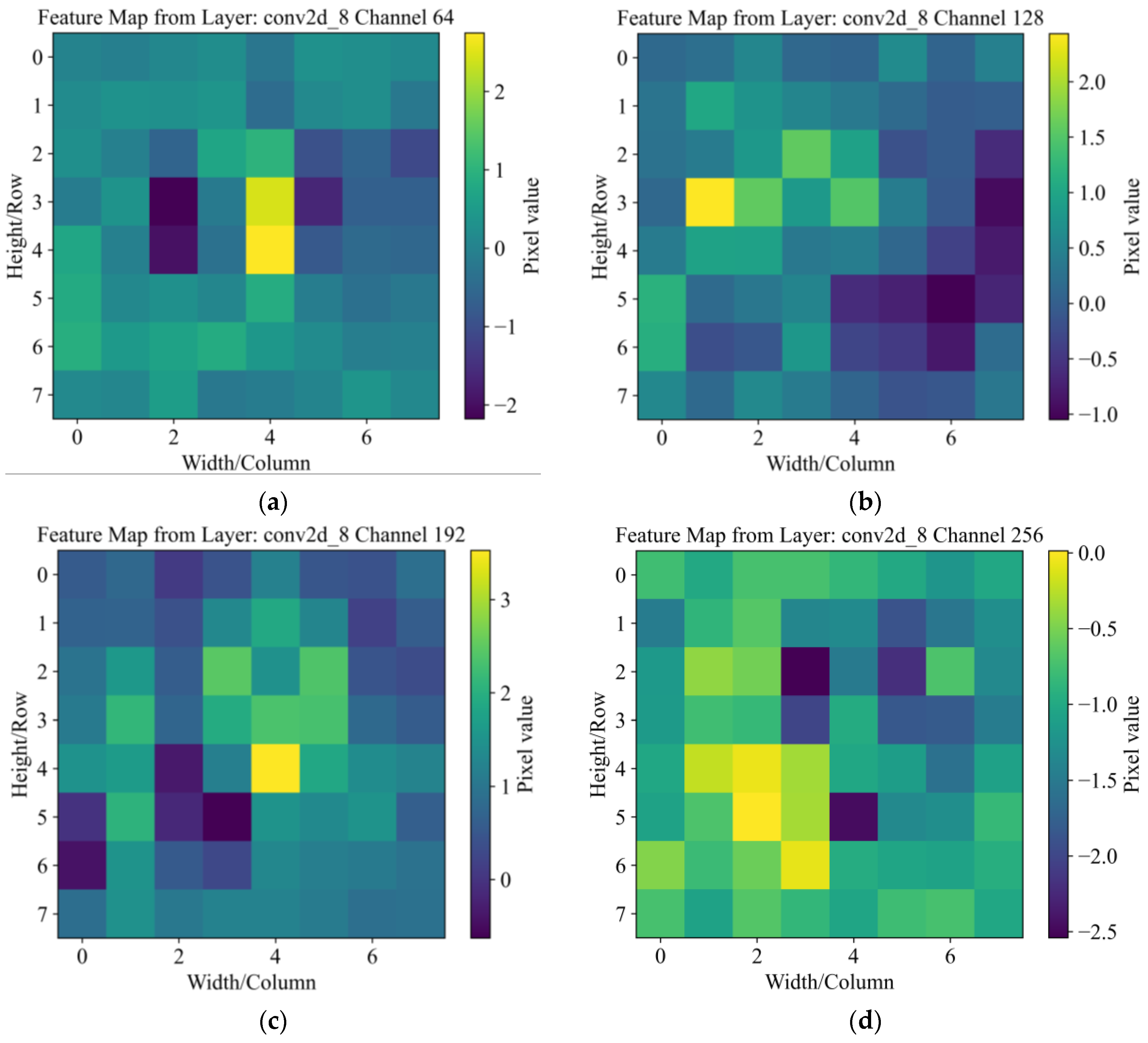



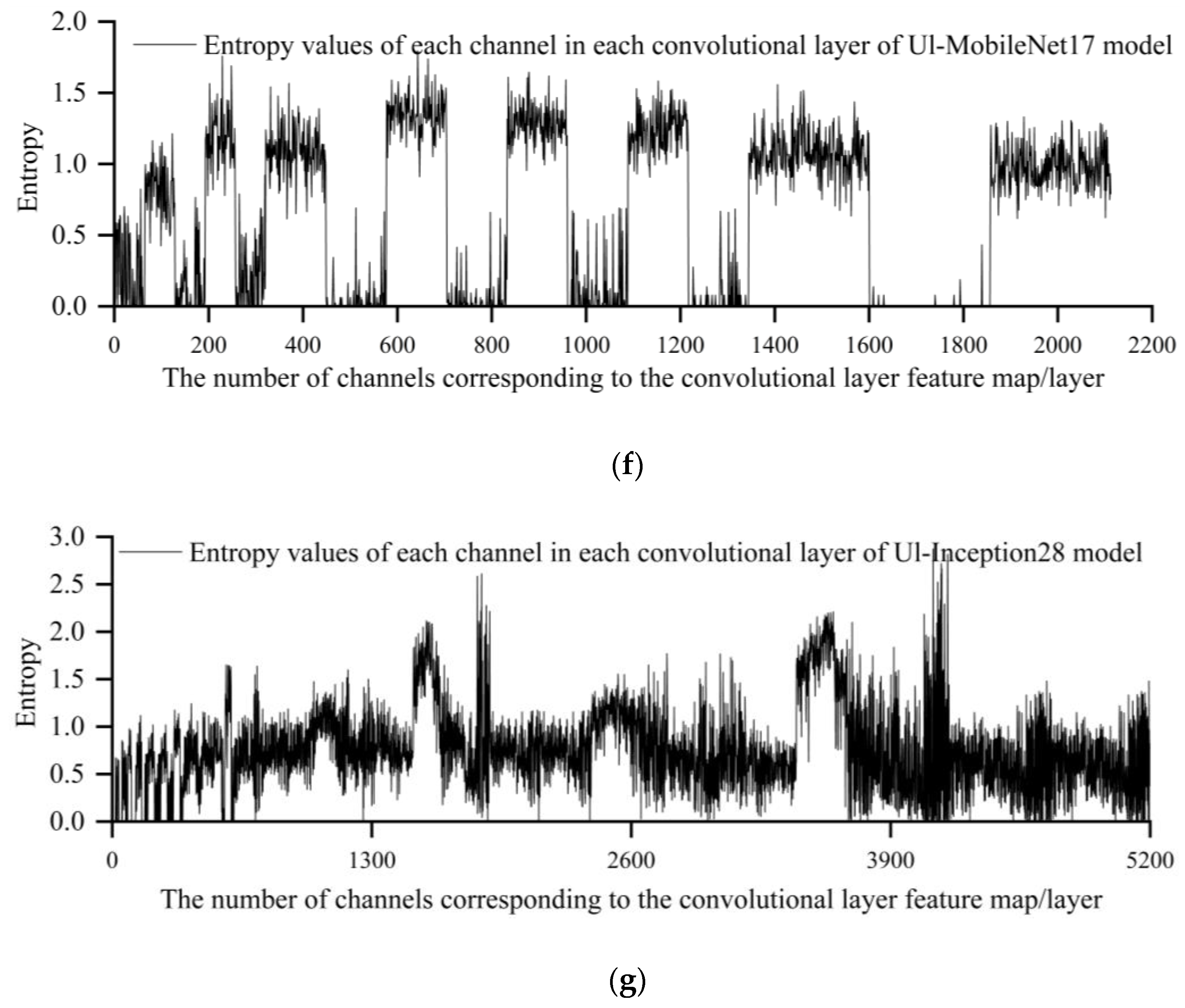
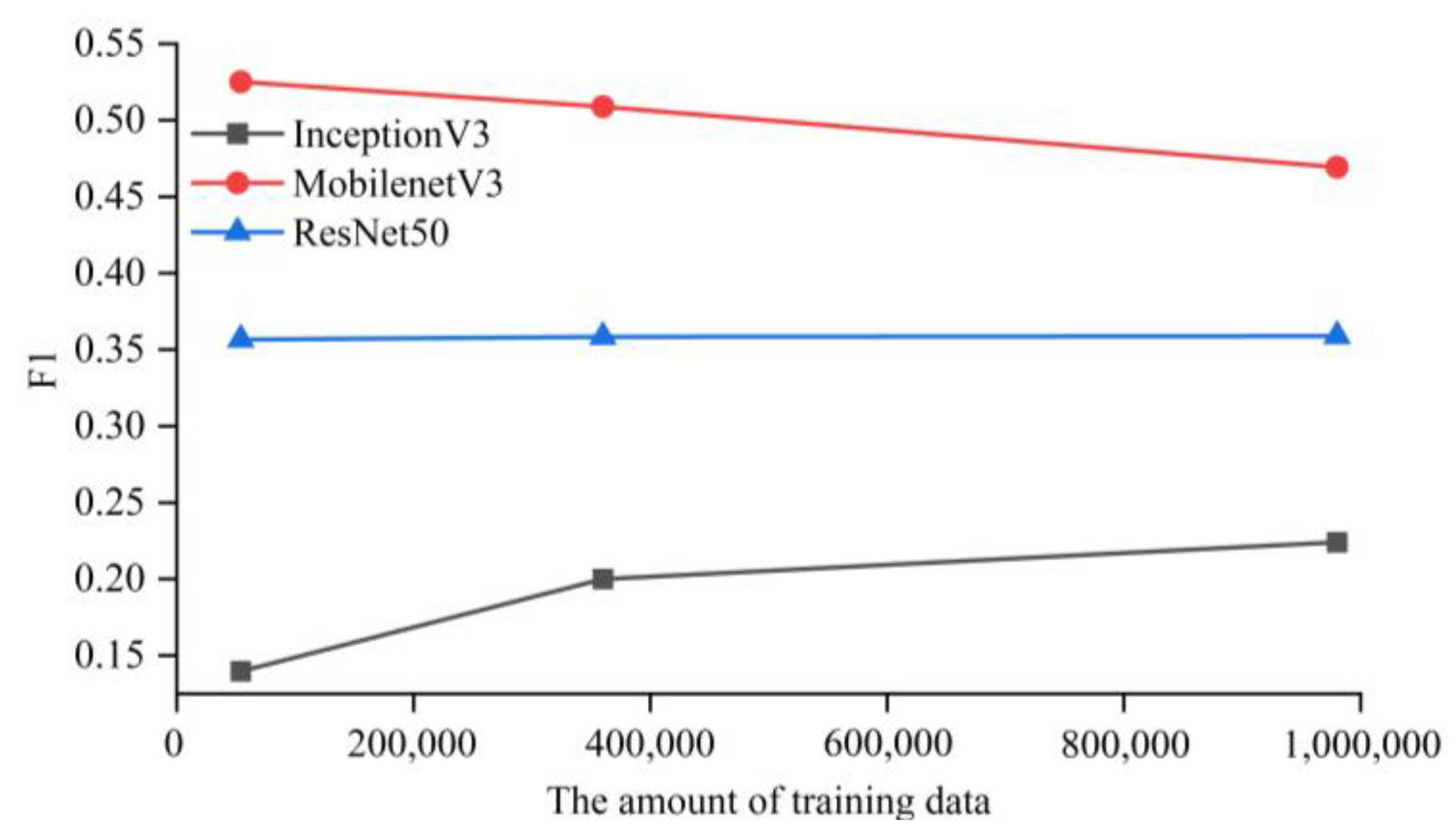
| Models | Total Params | Trainable Params | Non-Trainable Params |
|---|---|---|---|
| InceptionV3 | 23,851,784 | 23,817,352 | 34,432 |
| ResNet50 | 25,636,712 | 25,583,592 | 53,120 |
| MobileNetV3 | 2,554,968 | 2,542,856 | 12,112 |
| Ul-Inception28 | 834,066 | 830,706 | 3360 |
| Ul-ResNet12 | 325,570 | 324,578 | 992 |
| Ul-MobileNet17 | 214,722 | 210,498 | 4224 |
| Ul-TripleConv8 | 476,690 | 475,474 | 1216 |
| Evaluation Parameters | STA\LTA | Ul-Inception28 | Ul-ResNet12 | Ul-MobileNet17 | Ul-TripleConv8 | Average Ensemble | Voting Integration |
|---|---|---|---|---|---|---|---|
| Tp | 54 | 60 | 60 | 55 | 60 | 64 | 62 |
| Fp | 14 | 6 | 6 | 12 | 5 | 15 | 1 |
| Pe | 0.7941 | 0.9091 | 0.9091 | 0.8209 | 0.9231 | 0.8101 | 0.9841 |
| Re | 0.8182 | 0.9091 | 0.9091 | 0.8333 | 0.9091 | 0.9697 | 0.9394 |
| F1 | 0.806 | 0.9091 | 0.9091 | 0.8271 | 0.916 | 0.8828 | 0.9612 |
Disclaimer/Publisher’s Note: The statements, opinions and data contained in all publications are solely those of the individual author(s) and contributor(s) and not of MDPI and/or the editor(s). MDPI and/or the editor(s) disclaim responsibility for any injury to people or property resulting from any ideas, methods, instructions or products referred to in the content. |
© 2024 by the authors. Licensee MDPI, Basel, Switzerland. This article is an open access article distributed under the terms and conditions of the Creative Commons Attribution (CC BY) license (https://creativecommons.org/licenses/by/4.0/).
Share and Cite
Li, N.; Zhang, Y.; Zhou, X.; Sun, L.; Huang, X.; Qiu, J.; Li, Y.; Wang, X. Promoting Sustainable Development of Coal Mines: CNN Model Optimization for Identification of Microseismic Signals Induced by Hydraulic Fracturing in Coal Seams. Sustainability 2024, 16, 7592. https://doi.org/10.3390/su16177592
Li N, Zhang Y, Zhou X, Sun L, Huang X, Qiu J, Li Y, Wang X. Promoting Sustainable Development of Coal Mines: CNN Model Optimization for Identification of Microseismic Signals Induced by Hydraulic Fracturing in Coal Seams. Sustainability. 2024; 16(17):7592. https://doi.org/10.3390/su16177592
Chicago/Turabian StyleLi, Nan, Yunpeng Zhang, Xiaosong Zhou, Lihong Sun, Xiaokai Huang, Jincheng Qiu, Yan Li, and Xiaoran Wang. 2024. "Promoting Sustainable Development of Coal Mines: CNN Model Optimization for Identification of Microseismic Signals Induced by Hydraulic Fracturing in Coal Seams" Sustainability 16, no. 17: 7592. https://doi.org/10.3390/su16177592
APA StyleLi, N., Zhang, Y., Zhou, X., Sun, L., Huang, X., Qiu, J., Li, Y., & Wang, X. (2024). Promoting Sustainable Development of Coal Mines: CNN Model Optimization for Identification of Microseismic Signals Induced by Hydraulic Fracturing in Coal Seams. Sustainability, 16(17), 7592. https://doi.org/10.3390/su16177592







